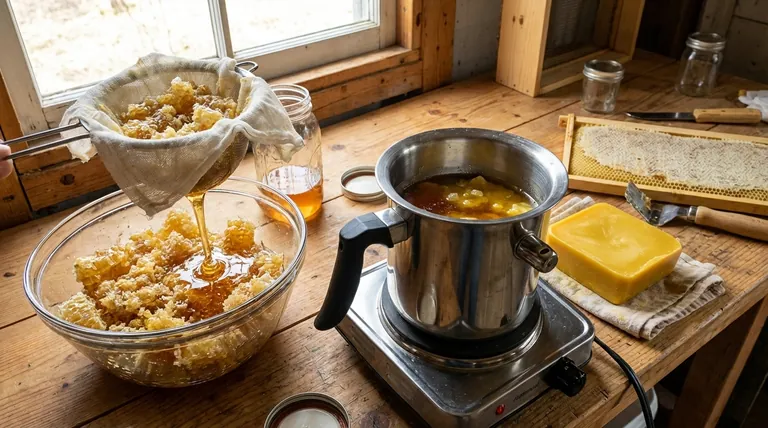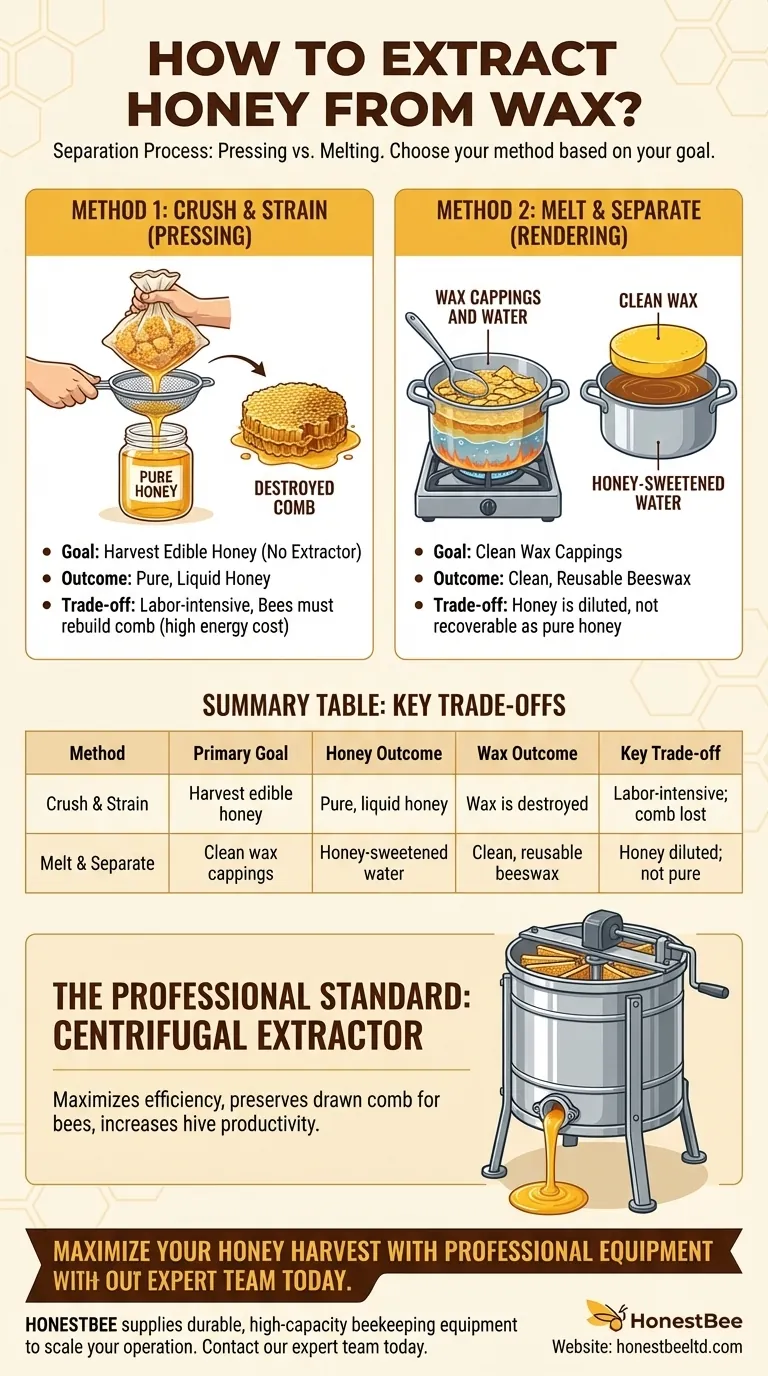At its core, extracting honey from wax is a process of separation, and the two most common methods are pressing the honey out or melting the wax in water. Pressing (or crushing and straining) yields pure honey but destroys the comb, while melting is best for cleaning wax and results in honey-sweetened water, not pure honey.
The method you choose depends entirely on your primary goal. Are you trying to harvest edible honey without an extractor, or are you trying to clean your wax cappings after extraction? Each objective requires a different approach.

Understanding the Two Extraction Methods
The technique you use comes down to your equipment and your desired outcome for the honey and the wax.
Method 1: Crush and Strain (Pressing)
This method is for harvesting edible, liquid honey when you do not have a centrifugal extractor.
You start by cutting the entire honeycomb from its frame. The comb is then placed inside a durable, porous cloth bag, like cheesecloth or a specialized nylon straining bag.
By squeezing, twisting, or using a mechanical press, you apply pressure to the bag. This forces the liquid honey out through the cloth, leaving the beeswax behind inside the bag.
The resulting honey must then be strained through a finer mesh to remove small particles of wax and other impurities before it is ready for bottling.
Method 2: Melt and Separate (Rendering)
This method is for cleaning wax that is already separated from the bulk of the honey, such as wax cappings left over after using an extractor.
Place the honey-laden wax cappings into a pot and cover them with water. Gently heat the pot until all the beeswax has melted into a liquid layer on top of the water.
Allow the pot to cool completely. As it cools, the pure, clean beeswax will solidify into a solid disk on the surface, which you can easily lift off.
The honey, however, will have dissolved into the water below. This honey-water is not pure honey but can be used to feed bees or in certain recipes. It cannot be bottled and sold as honey.
Understanding the Trade-offs
Neither of these methods is perfect. Choosing one requires you to balance efficiency, equipment cost, and the final state of your honey and wax.
Crush and Strain: Maximum Honey, Destroyed Comb
The primary advantage of this method is that it allows for a complete honey harvest without the expense of an extractor.
The major disadvantage is its destructive nature. The bees must expend significant energy and resources (consuming about 8 pounds of honey to produce 1 pound of wax) to rebuild the comb from scratch. It is also a sticky, labor-intensive process.
Melt and Separate: Clean Wax, Diluted Honey
This technique is the most effective way to clean your wax cappings for rendering into usable beeswax blocks.
Its key limitation is that you do not recover pure honey. The process yields honey-infused water, which has very limited uses. It is a salvage operation for cleaning wax, not a primary method for harvesting honey.
The Extractor: The Professional Standard
For context, most beekeepers use a centrifugal extractor. After an uncapping knife slices off the wax cappings, frames are spun, and centrifugal force pulls the honey out without damaging the comb.
This is the most efficient method by far, as it preserves the drawn-out comb. This saves the bees an immense amount of work, allowing them to focus on gathering more nectar and refilling the existing structure.
Making the Right Choice for Your Goal
Your decision should be guided by your specific objective.
- If your primary focus is harvesting edible honey without an extractor: Use the crush and strain method, but be aware that you are sacrificing the comb.
- If your primary focus is cleaning wax cappings after extraction: Use the melt and separate method to render clean wax, understanding the honey will be diluted into water.
- If your primary focus is long-term efficiency and hive health: Investing in a centrifugal extractor is the standard for preserving comb and maximizing your hive's productivity.
Ultimately, aligning your method with your goal ensures you get the result you need from your hard work.
Summary Table:
| Method | Primary Goal | Honey Outcome | Wax Outcome | Key Trade-off |
|---|---|---|---|---|
| Crush & Strain | Harvest edible honey without an extractor | Pure, liquid honey | Wax is destroyed (comb lost) | Labor-intensive; bees must rebuild comb |
| Melt & Separate | Clean wax cappings after extraction | Honey-sweetened water (not pure) | Clean, reusable beeswax | Honey is diluted and not recoverable |
Maximize Your Honey Harvest with Professional Equipment
As a commercial beekeeper or distributor, efficiency is key. While the methods above work for small-scale operations, a centrifugal extractor is the professional standard for preserving comb and maximizing yield.
HONESTBEE supplies the durable, high-capacity beekeeping equipment you need to scale your operation. We provide everything from uncapping knives to commercial-grade extractors, helping you save time and increase productivity.
Ready to upgrade your extraction process? Contact our expert team today to discuss the best equipment solutions for your apiary or distribution business.
Visual Guide

Related Products
- Beeswax Melter for Candle Making Honey Bee Wax Melter
- 8-Frame Electric Self-Reversing Honey Extractor Spinner for Commercial Honey Extraction Equipment
- 2 Frame Stainless Steel Manual Honey Spinner Extractor for Beekeeping
- HONESTBEE 3-Frame Manual Acrylic Honey Extractor
- HONESTBEE 72 Frame Industrial Electric Honey Extractor for Beekeeping
People Also Ask
- What is the flashpoint of beeswax? Essential Safety and Quality Tips for Beekeepers
- What is the best way to melt beeswax for candles? The Safest Method for Professional Results
- What do you use a wax melter for? From Home Fragrance to Professional Beekeeping
- What is the recommended temperature range for melting beeswax? Achieve Perfect Quality & Safety
- How do water jacket melters function? Achieve Gentle, Scorch-Free Melting for Sensitive Materials



















